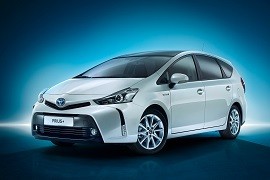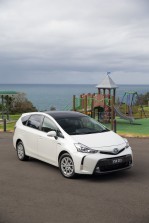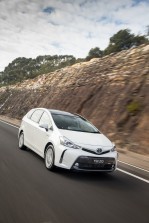Body style: Van
Segment: Medium MPV
Production years: 2015, 2016, 2017, 2018, 2019, 2020, 2021
 37 Photos
37 PhotosIn 2015, Toyota considered that it was time for a refresh for the Prius V, or Prius +, in specific markets, and the Japanese automaker tried to keep the sales figures up for this hybrid-powered mid-size minivan.
Two decades after the launch of the Prius’ first generation, the Japanese automaker expanded the range to several models, including the compact-sized Prius C and the versatile Prius V. The latter was introduced in 2011 and tried to attract customers who were trying to lower the emissions of their vehicles but without being forced to drive econoboxes with underpowered engines. For them, the Prius V was an excellent solution. Even if the car didn’t deliver breathtaking performance, it could still do its job for school runs, grocery, and even hauling the entire family on a long holiday. Toyota understood that besides fuel efficiency, an expensive vehicle should provide more, so it sweetened the deal with a nicer-looking design and better interiors.
As a result, the front fascia of the 2016 Toyota Prius V was more aggressive than the one from its non-facelifted sibling. It featured a trapezoidal-shaped grille interrupted by a black horizontal slat that housed the license plate. It was flanked on the lower side by the daytime running lights, which were integrated into the vertical side scoops. In addition, the automaker added a pair of round fog lamps to the lower side of the bumper. With the 2015 Prius V, Toyota also took the decisive step towards modern lighting, installing LED projector headlamps on the vehicle.
Thanks to the tell greenhouse, the MPV-styled Prius V could accommodate up to seven people on three rows of seats. The panoramic windshield and large side windows provided an airy ambiance inside the cabin, while all versions featured a dual panoramic sunroof. Out back, atop the almost vertical tailgate, the automaker installed a roof spoiler that helped the vehicle get a 0.29 Cd, which was higher than what the regular Pirus provided but better than any other minivan on the market. To furthermore update the car’s look, Toyota added new designs for the standard 16-inch alloy wheels and provided a 17-inch set as an option.
Inside, there were more changes than on the outside. The front high-mounted seats were available in SofTex material, which was a man-made leather. Like the rest of the Prius range, the Prius V featured a dashboard made from recycled materials, and that didn’t look too good on such a vehicle, but customers were happy with that. They understood that sometimes they had to forget some luxurious amenities for the Earth’s sake. A new display in the squared-looking instrument cluster placed in the middle of the dashboard provided more and clearer information to the driver despite its ‘80s analog styling. In addition, a 6.5-inch Toyota Entune multimedia system was found on the center stack. Depending on the options, it could provide navigation, music, and an online connection for weather forecasts and other pieces of information. The middle row consisted of sliding and reclining three individual seats, while the two rearmost ones were suitable for children.
Under the hood was the same drivetrain as in the regular Prius. The 1.8-liter gasoline engine was helped by an electric motor to produce a total output of 134 hp (136 PS). Thanks to the electronically-controlled CVT, the car could sprint from 0 to 60 mph (0-97 kph) in less than 11 seconds, which was good enough for most customers.
TOYOTA Prius v/Prius+ 2015, 2016, 2017, 2018, 2019, 2020, 2021
- 1.8 CVT (136 HP)
TOYOTA Prius v/Prius+
1.8 CVT (136 HP)
ENGINE SPECS - 1.8 CVT (136 HP) | |
|---|---|
| Cylinders: | L4 |
| Displacement: | 1797 cm3 |
| Power: | 72.8 KW @ 5200 RPM 99 HP @ 5200 RPM 98 BHP @ 5200 RPM |
| Torque: | 105 lb-ft @ 2800 RPM 142 Nm @ 2800 RPM |
| Fuel System: | Multipoint Injection |
| Fuel: | Hybrid |
PERFORMANCE SPECS | |
|---|---|
| Top Speed: | 103 mph (166 km/h) |
| Acceleration 0-62 Mph (0-100 kph): | 11.3 s |
TRANSMISSION SPECS | |
|---|---|
| Drive Type: | Front Wheel Drive |
| Gearbox: | e-CVT |
BRAKES SPECS | |
|---|---|
| Front: | Ventilated Discs |
| Rear: | Discs |
TIRES SPECS | |
|---|---|
| Tire Size: | 205/60R16 |
DIMENSIONS | |
|---|---|
| Length: | 181.9 in (4620 mm) |
| Width: | 70.1 in (1781 mm) |
| Height: | 62.6 in (1590 mm) |
| Front/rear Track: | 60.2/60.5 in (1,529/1,537 mm) |
| Wheelbase: | 109.4 in (2779 mm) |
| Ground Clearance: | 5.7 in (145 mm) |
| Cargo Volume: | 34.3 cuFT (971 L) |
| Aerodynamics (Cd): | 0.29 |
WEIGHT SPECS | |
|---|---|
| Unladen Weight: | 3241 lbs (1470 kg) |
| Gross Weight Limit: | 4751 lbs (2155 kg) |
FUEL ECONOMY (NEDC) | |
|---|---|
| City: | 61.9 mpg US (3.8 L/100Km) |
| Highway: | 56 mpg US (4.2 L/100Km) |
| Combined: | 57.4 mpg US (4.1 L/100Km) |
| CO2 Emissions: | 96 g/km |
| Notes |
|---|
| Specified cargo capacity was measured with two-row seats in place. Hybrid system Electric motor power: 60 kW (82 HP) Electric motor torque: 142 Nm (105 lb-ft) Total system power: 100 kW (136 HP) Total system torque: 207 Nm (153 lb-ft) |




































